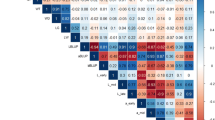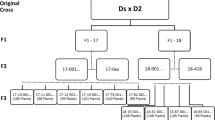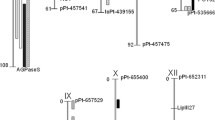Abstract
A genetic map was constructed with a combination of isozymes, restriction fragment length polymorphisms (RFLPs) and randomly amplified polymorphic DNA (RAPDs) to apply quantitative trait loci (QTL) analysis to identify genetic factors that contribute to chip color in potato. The diploid population used was a cross between aSolanum tuberosum haploid andS. chacoense hybrid used as female parent and aS. phureja clone used as male. Chip color was determined visually on samples fried from tubers stored at 10C. On a scale of 1 (light color) to 10 (dark color), the population ranged from 2 to 8 while the parents average chip color was 3.5. Based upon one-way ANOVAs (P < 0.05), 13 genetic markers showed significant associations which represent a total of six QTLs. A multiple locus model based upon the markers that have the largest effect per QTL explained 43.5% of the phenotypic variation for chip color in the population and increased to 50.5% when one significant epistatic interaction was included in the model. All the significant marker associations were identifed in theS. tuberosum-S. chacoense hybrid. Through preliminary data, the results of this study suggest that additive effects contribute a significant portion of the genetic variation for chip color. The identification of these QTLs for chip color variation provides the means to apply marker-assisted selection to introgress these genes into the cultivated potato germplasm.
Compendio
Se construyó un mapa genético con una combinacion de isozimas, polimorfismos de restricción de la longitud de los fragmentes (RFLPs) y DNA polimórfico amplificado al azar (RAPDs), para aplicar el análisis de loci de caracteristicas cuantitativas (QTL) en la identificatión de factores genéticos que contribuyen al color de la papa en la fritura a la inglesa. La población diploide utilizada fue un cruzamiento entre un haploideSolanum tuberosum y un híbridoS. chacoense, usado como progenitor femenino, y un cloneS. phureja usado como macho. Se determinó visualmente el color de la papa frita a la inglesa sobre muestras fritas de tubérculos almacenados a 10 C. En una escala de 1 (color claro) a 10 (color oscuro), la población varió de 2 a 8, mientras que el color en los progenitores promedió 3.5. Basándose en ANOVAs de un solo sentido (P < 0.05), 13 marcadores genéticos mostraron asociaciones significativas que representan un total de seis QTLs. Un modelo de locus múltiples, basado en los marcadores que tuvieron el mayor efecto por QTL, explicó el 43.5% de la variación fenotípica de la población, para el color de la papa en fritura a la inglesa y se incrementó a 50.5% cuando se incluyó en el modelo una interacción epistática significativa. Se identificaron todas las asociaciones significativas de los marcadores en el híbridoS. tuberosum-S. chacoense. A través de la información preliminar, los resultados de este estudio sugieren que los efectos aditivos contribuyen en proporción significativa en la variación genética para el color de la papa frita a la inglesa. La identificación de estos QTLs, para variación del color en la fritura, provee los medios para aplicar la selección apoyada por marcadores en la introgresión de estos genes en el germoplasma de papa cultivada.
Similar content being viewed by others
Literature Cited
Accatino, P.L. 1973. Inheritance of the potato chip color at the diploid and tetraploid levels of ploidy. Ph.D. Thesis, Univ. Wisconsin. 62 p.
Bonierbale, M., R. Plaisted and S.D. Tanksley. 1988. RFLP maps based on a common set of clones reveal modes of chromosomal evolution in potato and tomato. Genetics 120: 1095–1103.
Cunningham, C.E. and F.J. Stevenson. 1963. Inheritance of factors affecting potato chip color and their association with specific gravity. Am Potato J 40: 253–265.
Freyre, R. and D.S. Douches. 1994. Isoenzymatic identification of quantitative traits in crosses between heterozygous parents: Mapping tuber traits in diploid potato (Solarium spp). Theor Appl Genet 87(7): 764–772.
Freyre, R., S. Warnke, B. Sosniski and D.S. Douches. 1994. Quantitative trait loci analysis of tuber dormancy in diploid potato (Solanum spp). Theor Appl Genet (in press).
Freyre, R. and D. Douches. 1993. Assessment of molecular marker technology for quantitative trait loci analysis in diploid potato. Am Potato J 70: 811 (Abstr).
Gebhardt, C. 1994. RFLP mapping in potato of qualitative and quantitative genetic loci conferring resistance to potato pathogens. Am Potato J 71(5): 339–346.
Gebhardt, C., E. Ritter, A. Barone, T. Debener, B. Walkemeier, U. Schachtschabel, H. Kaufmann, R.D. Thompson, M.W. Bonierbale, M.W. Ganal, S.D. Tanksley and F. Salamini. 1991. RFLP maps of potato and their alignment with the homoeologous tomato genome. Theor Appl Genet 83: 49–57.
Gebhardt, C., E. Ritter, T. Debener, U. Schachtschabel, B. Walkemeier, H. Uhrig and F. Salamini. 1989. RFLP analysis and linkage mapping inSolanum tuberosum. Theor Appl Genet 78: 65–75.
Habib, A.T. and H.D. Brown. 1957. Role of reducing sugars and amino acids in the browning of potato chips. Food Technology 11: 85–89.
Hoover, E.F. and P.A. Xander. 1961. Potato composition and chipping quality. Am Potato J 38: 163–170.
Hughes, J.C. and T.J. Fuller. 1984. Fluctuations in sugars in cv. Record during extended storage at 10C. Potato Res 27: 229–236.
Iritani, W.M. and L.D. Weiler. 1980. Sugar development in potatoes. Ext Bull 0717. Wash Agr Expt Station, Pullman.
Johansen, R.H., J.T. Schulz and J.E. Huegelet. 1969. Norchip, a new early maturing chipping variety with high total solids. Am Potato J 46: 254–258.
Keim, P., B.W. Diers and R.C. Shoemaker. 1990. Genetic analysis of soybean hard seediness with molecular markers. Theor Appl Genet 79: 465–469.
Loiselle, F., G.C.C. Tai and B.R. Christie. 1990. Genetic components of chip color evaluated after harvest, cold storage, and reconditioning. Am Potato J 67: 633–646.
Paterson, A.H., S. Damon, J.D. Hewitt, D. Zamir, H.D. Rabinowitch, E.S. Lincoln, E.S. Lander and S.D. Tanksley. 1991. Mendelian factors underlying quantitative traits in tomato: comparison across species, generations, and environments. Genetics 127: 181–197.
Pavek, J.J., D.L. Corsini, S.L. Love, D.C. Hane, D.G. Holm, M.W. Martin, A.R. Mosley and R.E. Thornton. 1991. Gemchip: A new potato variety with chipping quality and verticillium resistance for the western U.S. Am. Potato J 68: 461–466.
Pereira, A. da S., R.H. Coffin, R.Y. Yada and V.S. Machado. 1993. Inheritance patterns of reducing sugars in potato tubers after storage at 12C and 4C followed by reconditioning. Am Potato J. 70: 71–76.
Quiros, C.F., A. Ceada, A. Georgescu and J. Hu. 1993. Use of RAPD markers in potato genetics: segregations in diploid and tetraploid families. Am Potato J 70: 35–42.
Ritter, E., T. Debener, A. Barone, F. Salamini and C. Gebhardt. 1991. RFLP mapping on potato chromosomes of two genes conferring resistance to potato virus X (PVX). Mol Gen Genet 227: 81–85.
Shallenberger, R.S., O. Smith and R.H. Treadway. 1959. Role of sugars in the browning reaction in potato chips. Ag Food Chem 7: 274–277.
Stevenson, F.J., R.V. Akeley and C.E. Cunningham. 1964. The potato—Its genetic and environmental variability. Am Potato J 41: 46–53.
Talbut, W.F. and O. Smith. 1975. Potato Processing. 3rd ed. Avi Publishing Co., Inc.
Tanksley, S.D., N.D. Young, A.H. Paterson and M.W. Bonierbale. 1989. RFLP mapping in plant breeding: New tools for an old science. Biotechnology 7: 257–264.
Van Den Berg,J.H., M.W. Bonierbale, E.E. Ewing and R.L. Plaisted. 1993. Genetic mapping of loci associated with earliness of tuberization and tuber dormancy inSolanum tuberosum andS. berthaultii. Third International Symposium on the Molecular Biology of the Potato, July 25–30, 1993, Santa Cruz, California. p 5.
Watada, A.E. and R. Kunkel. 1955. The variation in reducing sugar content in different varieties of potatoes. Am Potato J 32: 132–140.
Weaver, M.L. and H. Timm. 1983. Significance of the fructose/glucose ratio in screening potato breeding lines with processing potential. Am Potato J 60: 329–338.
Webb, R.E., D.R. Wilson, J.R. Shumaker, B. Graves, M.R. Henninger, J. Watts, J.A. Frank, and H.J. Murphy. 1978. Adantic: A new potato variety with high solids, good processing quality, and resistance to pests. Am. Potato J 55: 141–145.
Yencho, G.C., M.W. Bonierbale, W.M. Tingey and R.L. Plaisted. 1993. Genetic mapping of traits associated with resistance to the Colorado Potato Beetle. Am Potato J 70: 858 (Abstr).
Author information
Authors and Affiliations
Additional information
former Ph.D. student
Rights and permissions
About this article
Cite this article
Douches, D.S., Freyre, R. Identification of genetic factors influencing chip color in diploid potato (Solanum spp.). American Potato Journal 71, 581–590 (1994). https://doi.org/10.1007/BF02851523
Accepted:
Issue Date:
DOI: https://doi.org/10.1007/BF02851523




